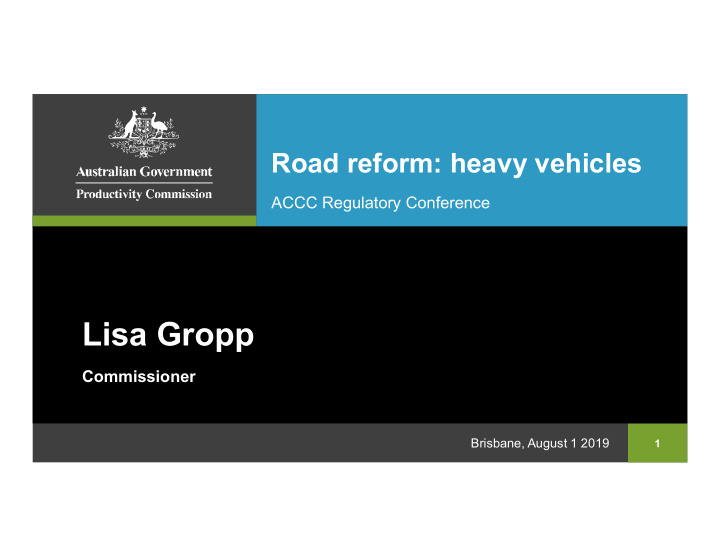



Road reform: heavy vehicles ACCC Regulatory Conference Lisa Gropp Commissioner Brisbane, August 1 2019 1
What heavy vehicles pay now • A share of actual capital and current spending on roads (PAYGO) – In principle PAYGO does not imply a subsidy, as users bear cost of capital • Share reflects estimates of attributable road damage and capital costs and allocation of (large) common costs • PC 2006 found HVs on average ‘paid their way’ within a range of reasonable cost attribution estimates – Road overall not subsidised relative to rail (accounting for externalities) • But HV charges would need to rise to reflect increased road spending Road reform 2
But significant deficiencies and inefficiencies • Network average charges unrelated to distance and which roads travelled lead to cross subsidies within and across HV classes • Backward-looking network average charges provide limited information to road planners • PAYGO leads to intertemporal cross subsidization with swings in spending (though smoothed by rolling averages) • Revenue streams disconnected from road services providers • Road planning, investment and maintenance decisions not well coordinated across levels of government, not necessarily efficient and often subject to political influence (risks of poor decisions borne by road users) Road reform 3
Delivering efficiency improvements • Better price signals are part of the solution, but not in isolation • Direct charging systems costly and must be compared with efficiency improvements, not revenue, to assess net benefits • Institutional reform essential for linking better information about road use and revenues to integrated planning, investment and maintenance decisions and achieving potential efficiency gains – And critical for demonstrating the potential benefits of pricing and other reforms to road users Road reform 4
Would a building block approach help? • Better match road services to their use over time (reducing intertemporal cross subsidies) • Link charges to efficient (economic) costs not actual spending – shifting risks of sub-optimal spending to road providers (or just other road users and taxpayers?) – without institutional reform, no guarantee that efficiency of road services would improve (although transparent identification of efficient spending might exert some positive influence?) • Without direct charges, would still set highly averaged HV charges • Greater informational requirement (eg RAB) and more opaque than PAYGO? Road reform 5
Managing and explaining transition • NTC exploratory estimates of RAB suggest significant price increases cf PAYGO – Why? Valuation/attribution issues or has road spending been too low? – Higher charges would have to be demonstrably linked to better road services for HVs (under PAYGO they consider they have already paid for the roads they use) Road reform 6
Lining up the ducks • Economic regulation/building block methodology is part of the solution • But what is the entity being regulated? • Forward-looking charges will be an integral part of a commercially-oriented, independent entity with responsibility for delivering efficient road services (even for part of the network) • The critical reform challenge is for governments to cede decision-making (and revenue streams) to such an entity Road reform 7
Thank you Road reform 8
Recommend
More recommend